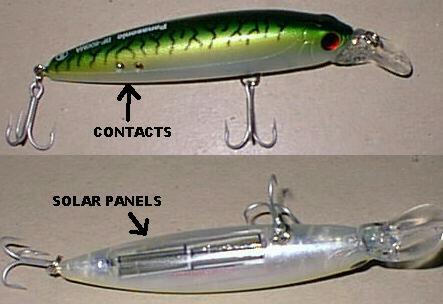



The Paul Bunyan Bait Company of Minneapolis, Minnesota was one of the early tackle companies to make a lure which had a battery in it, the purpose of which in this case was to cause the head of the lure to light up. The "Electro-Lure" (Paul Bunyan #1001) as it was called, was actually a product of the Pal Tool Company who sold the rights to the lure to Paul Bunyan around 1939. Sometime later, Paul Bunyan sold the rights to Lloyd & Co. of Illinois, who marketed it under the name, "Lighted Pirate."
According to the listing in the 1939 Paul Bunyan catalog, it "...wobbles through the water with a beam of light flashing from it's head." However, the light does not actually flash. Rather, the metal diving lip has two wings attached to either side and the light is reflected off the sides. Coupled with the wobbling action of the lure, it gives the effect of 'flashing'.
The lure uses a standard size AA battery and flashlight bulb. To work, the outer wrapping on today's batteries must be removed. A copper spring wire bulb holder is then 'wrapped' onto the body of the battery and the bulb screwed into it. When the two halves of the body are screwed together, the base of the bulb makes contact with the battery and the bulb lights. To turn the bulb off, the two halves were unscrewed until the light went out.
One of the main problems with this lure was the fact that the heat produced by the bulb was controlled by the fact it was in the water which cooled the lure. However, if left on while out of the water for a period of time, the lure's plastic had a strong tendency to melt! I've seen a number of these with some melting and/or scorching of the paint and plastic, probably because the fisherman either forgot to unscrew the two halves or more likely did so but thru bouncing and jostling around in a tackle box, the bulb and battery made contact.
The lure also had a fiber washer to help make it waterproof when the two parts were screwed together since water and electricity (and batteries) do not mix well. The washer is occasionally missing from these as well as they tended to get brittle over time and break off.
Colors for this lure include green, yellow, white, and silver, all with a red head, and a transparent amber color which was not a Paul Bunyan listed color but was probably made by Pal or Lloyd's. The price range for these lures in excellent condition is $75 to $100.


Frankly, I don't think you can call yourself a fisherman unless you got one of these! Isn't technology great?

If you have any further information on any of the items displayed on this page which you'd like to share, please send your comments to me and I'll update the page accordingly. Contributions of interesting items and/or unknowns are encouraged. Lures pictured in Lure Lore are not for sale.

Comments? EMAIL ME!
Web Author: Tom Jacomet
Copyright ©1998 by Tom Jacomet - ALL RIGHTS RESERVED